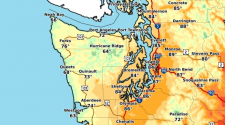American tourists — chafing at social distancing rules, impatient over the rollout of coronavirus vaccines — are surging back to Cancún.
William Cruz can’t decide whether to welcome them, or worry about a new wave of coronavirus cases.
“Should gringos come here?” asked the father of two. who waits tables in the city’s popular tourist district.
He knows he needs them, desperately.
[Mexico eases coronavirus restrictions in popular tourist cities ahead of spring break]
He was forced to close a beer store he owned after revenue collapsed last year. Does he want outsiders to come to Cancún?
Cruz answers his own question. At first, he says, “I’d say no … because you risk infecting your family and us.”
Then he thinks about what it would mean to lose yet another job. “So, let them come,” he said, laughing at the contradiction. “What I think most about is the money, to bring something back home.”

James Hayes, 46, and Anthony Rega, 43, visiting from New Jersey, pose for a portrait at the Grand Oasis Cancún resort on March 20.

Visitors speak with a server at Mandala Beach Club, a popular tourist destination.

Tourists pose for photos at the Forum By the Sea mall.

Beachgoers relax in Cancún.
TOP LEFT: James Hayes, 46, and Anthony Rega, 43, visiting from New Jersey, pose for a portrait at the Grand Oasis Cancún resort on March 20. TOP RIGHT: Visitors speak with a server at Mandala Beach Club, a popular tourist destination. BOTTOM LEFT: Tourists pose for photos at the Forum By the Sea mall. BOTTOM RIGHT: Beachgoers relax in Cancún.
TOP: Beachgoers take to the sand and surf in Cancún. TOP LEFT: James Hayes, 46, and Anthony Rega, 43, visiting from New Jersey, pose for a portrait at the Grand Oasis Cancún resort on March 20. TOP RIGHT: Visitors speak with a server at Mandala Beach Club, a popular tourist destination. BOTTOM LEFT: Tourists pose for photos at the Forum By the Sea mall. BOTTOM RIGHT: Beachgoers relax in Cancún.
[More Americans are traveling to Mexico’s Riviera Maya than ever before. The parties have led to more coronavirus cases.]
Under Mexico’s four-stage “stoplight” color-coded system, the state of Quintana Roo is considered phase yellow. Hotels and restaurants are allowed to open, but at 60 percent capacity, and nightclubs are required to be closed entirely.
But with tourists who seem to want to keep partying, economic pressures make it hard for Cancún to contemplate turning visitors away.
 Anyeli Rondon, 17, receives a coronavirus test in Cancún on March 19 before traveling home to Venezuela.
Anyeli Rondon, 17, receives a coronavirus test in Cancún on March 19 before traveling home to Venezuela. Anyeli Rondon, 17, receives a coronavirus test in Cancún on March 19 before traveling home to Venezuela.
Tourism accounts for 87 percent of the state’s gross domestic product. “So, if anything happens to tourism, it happens to all of us,” said Marisol Vanegas, tourism secretary for Quintana Roo.
The city saw more than 6 million tourists in 2019. That number dropped to nearly half in 2020, as countries locked down because of the pandemic, Vanegas said.
But the tourists are back this year, with Vanegas projecting 5 million arrivals in 2021.
Many of those visitors are Americans, according to Vanegas, with visitors from Texas topping the list.
“The reason is that North Americans cannot travel to Europe,” Vanegas said. “Many of the airlines are redirecting flights, as an alternative, to Cancún.”
 A man pushes luggage in Cancún’s Hotel Zone.
A man pushes luggage in Cancún’s Hotel Zone. 
Visitors crowd elevators at the Grand Oasis Cancún resort.

A worker sets up tables for an oceanside wedding party.

Employees greet patrons at Mandala Night Club.

Visitors walk through a tourist-heavy area known as the Hotel Zone.
TOP LEFT: Visitors crowd elevators at the Grand Oasis Cancún resort. TOP RIGHT: A worker sets up tables for an oceanside wedding party. BOTTOM LEFT: Employees greet patrons at Mandala Night Club. BOTTOM RIGHT: Visitors walk through a tourist-heavy area known as the Hotel Zone.
TOP: A man pushes luggage in Cancún’s Hotel Zone. TOP LEFT: Visitors crowd elevators at the Grand Oasis Cancún resort. TOP RIGHT: A worker sets up tables for an oceanside wedding party. BOTTOM LEFT: Employees greet patrons at Mandala Night Club. BOTTOM RIGHT: Visitors walk through a tourist-heavy area known as the Hotel Zone.
The economic boom poses a health hazard for workers, especially in some crowded nightclubs along Kukulcán Boulevard that remain open by serving food, thus technically qualifying as restaurant-bars.
Rigoberto Trujillo, 32, a security guard at a nightclub on the tourist strip, says he worries about catching the virus but that he is even more worried about not having work.
His hours were cut to a few days a week during the early days of the pandemic. With the spring break influx, he is back to full time. But his fear of the virus remains.
“We try to provide a good service,” he said. “I want that service to continue being that way, so I have to take care of myself as well.” Every night he changes out of his work clothes before entering his home and then takes a shower before greeting his family.
Patrons cheer on a mariachi band at the Grand Oasis Cancún resort.
[Mexican beach destination tries to lure tourists back in the midst of the pandemic]
On a recent evening, spring break revelers — many unmasked — packed a popular nightclub on Kukulcán Boulevard. Masked security guards patted down maskless tourists before they joined at least 100 others.
Scantily clad dancers performed in feather-plumed headdresses and bedazzled face masks. When the show was over, house music blasted and revelers flooded the dance floor. Masked waiters passed through the crowd with trays of drinks.
Across the street, hundreds of partyers lined up to see an indoor cabaret show. A representative for the club said the arena holds 1,500 people and is operating at 40 percent capacity.
 Dancers perform onstage at a Cancún nightclub.
Dancers perform onstage at a Cancún nightclub. 
A worker checks the temperature of guests at Coco Bongo Show and Disco.

Patrons watch masked performers at Congo Bar.

An employee gives a guest a shot at Coco Bongo Show and Disco.

A worker cleans as employees and partyers dance at Coco Bongo Show and Disco.
TOP LEFT: A worker checks the temperature of guests at Coco Bongo Show and Disco. TOP RIGHT: Patrons watch masked performers at Congo Bar. BOTTOM LEFT: An employee gives a guest a shot at Coco Bongo Show and Disco. BOTTOM RIGHT: A worker cleans as employees and partyers dance at Coco Bongo Show and Disco.
TOP: Dancers perform onstage at a Cancún nightclub. TOP LEFT: A worker checks the temperature of guests at Coco Bongo Show and Disco. TOP RIGHT: Patrons watch masked performers at Congo Bar. BOTTOM LEFT: An employee gives a guest a shot at Coco Bongo Show and Disco. BOTTOM RIGHT: A worker cleans as employees and partyers dance at Coco Bongo Show and Disco.
The state government has strictly enforced partial capacity at restaurants across the state, and hotels maintain limited capacity — some businesses were shut down after flouting the measures.
But it seems this party strip of clubs in Cancún has found a way around the restrictions.
The nightclubs, packed with tourists, have not escaped Miriam Cortés, the president of the Vacation Club Association of Quintana Roo.
“Authorities have failed to act despite having all the evidence. It’s not like it’s hidden; you walk down the street and you see it. You see it every single day,” she said of the clubs teeming with tourists. “We’re outraged.”
She said she is concerned about service industry workers in compromised conditions. “But we are also worried about people being able to eat,” she said. International tourists returning to some countries, such as the United States, are required to show a negative test before boarding their flights home.
And when an international traveler tests positive for the coronavirus in Cancún, many hotels promise to provide a two-week quarantine stay free. But the quarantine is not strictly enforced — and even some testing has come into question.
In one case in Cancún, nearly two weeks ago, an unaccredited lab was found to have given faulty coronavirus tests to 44 Argentine tourists.
Mexican authorities stated the tourists provided negative tests before boarding a plane to Argentina. When they arrived to their destination, the tourists were administered another test and all 44 resulted positive for covid.
Bartenders prepare for patrons to arrive at Coco Bongo Show and Disco.
Ellie Langdon, a 19-year-old college student from Minnesota, had visited one of the clubs in the party strip the night before. She said the restrictions in the United States are overblown.
“If I’m not sick, I’m not going to put my whole life on hold,” she said. “You should come here. And you should have the best time and get your money’s worth because it’s vacation and you’re not going to come to Cancún and not live it up.”
She didn’t plan to quarantine when she returned home.
Anthony Rega, a 43-year-old New Jersey mortgage broker on vacation with a friend, said he too visited the clubs on the strip. “Everybody was on top of each other there,” he said of partyers not observing social distancing.
He said he didn’t see the need to quarantine for two weeks, as long as he did not feel ill.
“If I feel okay after a day or two — obviously I got a negative test coming home — I’m going to think it’s clear sailing from there.”
A discarded mask is submerged in a pool at the Grand Oasis Cancún.




_square-225x125.jpg)














